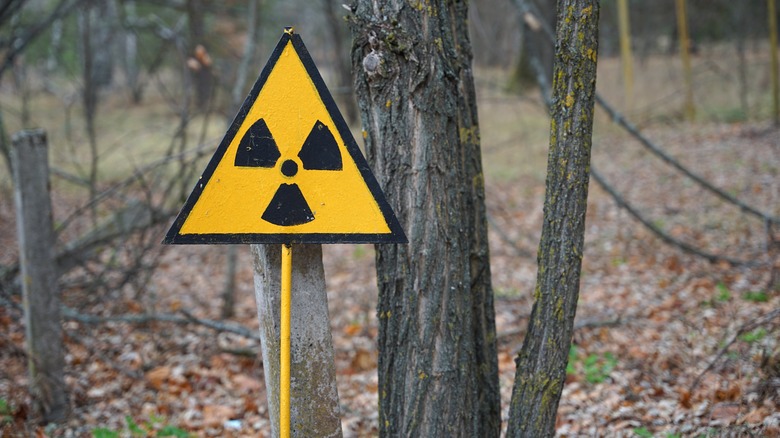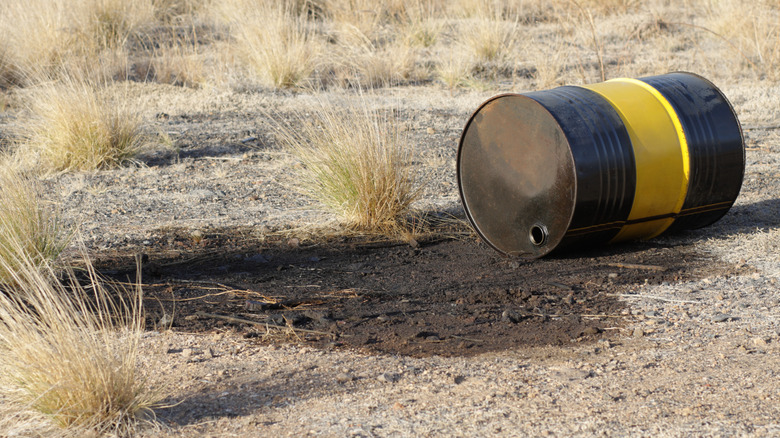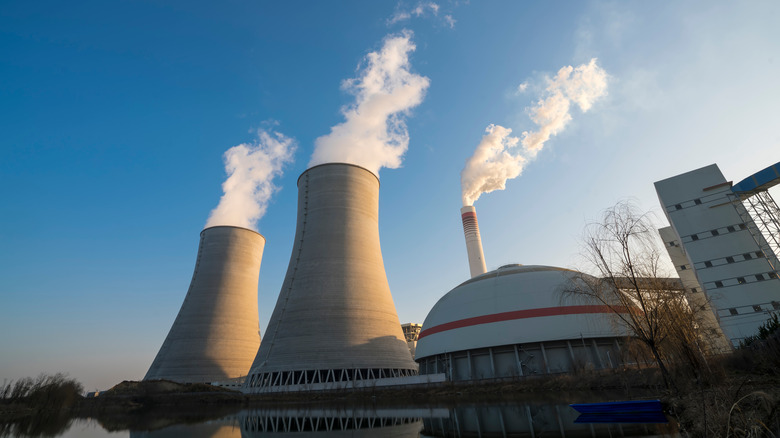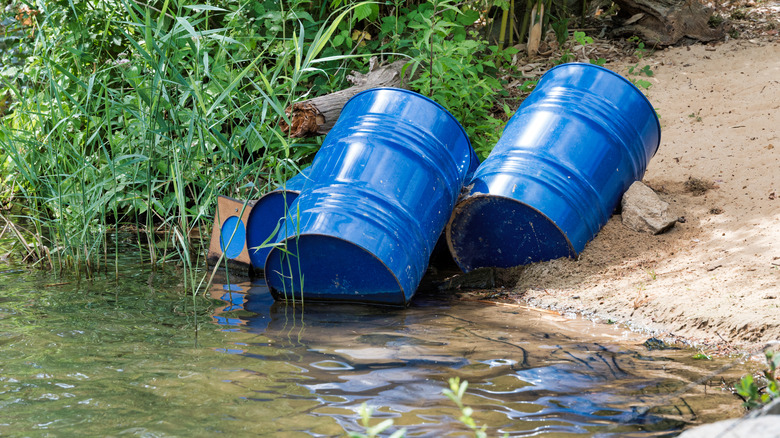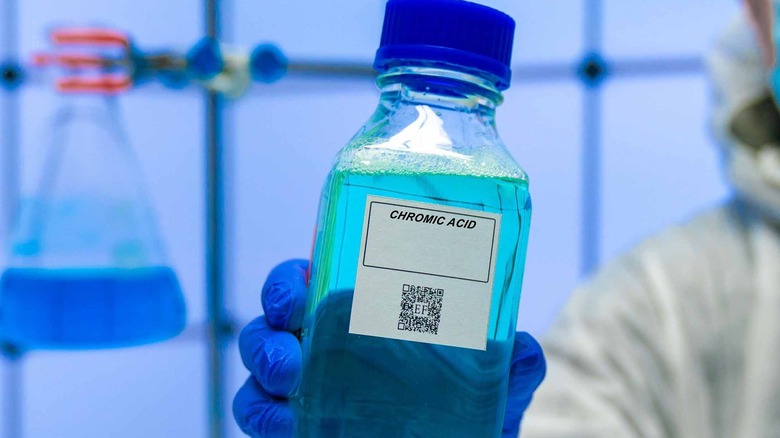Why This Area Just Outside Of Denver Is Radioactive
Rocky Flats, Colorado, was a hotbed of nuclear mismanagement that has left a lasting legacy for its residents and former employees (per The Pittsburgh Press). The Rocky Flats nuclear plant opened its doors in 1952 as a hub for plutonium detonators that are used to set off nuclear bombs (per Britannica). According to the National Nuclear Security Administration, the bowling-ball-sized plutonium pits are a crucial part of any nuclear bomb — they're what gives the bomb the energy it needs to explode. Contained on 11 square miles of land, the factory was a secret at first, warning employees not to disclose that the plant made nuclear bomb parts (per Britannica).
According to The Colorado Department of Public Health & Environment, Rocky Flats was a nuclear weapons production hub for nearly 40 years. The nuclear weapons plant has a decades-long history of mistakes — a sentence one hopes to never read (via The New York Times). In 1957, the plant exploded, which damaged every last one of the plant's industrial-grade filters. Since the filters hadn't been changed since the plant opened, several years' worth of hazardous uranium and plutonium dust was launched into the air from 620 filters. No one was evacuated from Rocky Flats, Colorado and surrounding towns, even though the results were devastating.
Per The New York Times, the toxic dust was found 12 miles away when the Atomic Energy Commission tested the dirt at a nearby elementary school to find that it was chock-full of radioactive materials.
Toxic dirt at the elementary school
In the late 1950s, leukemia rates in the plant's surrounding towns were double the national average (via The New York Times). Infant death rates began to grow after 1957. But still, the Atomic Energy Commission didn't tell the students or parents and instead kept mum about the whole thing.
The Rocky Flats plant didn't clean up its act — things got worse from there (per Britannica). Since the facility stored metal barrels outside in the elements, the barrels became leaky. From 1958 onward, the barrels were a consistent source of oil leaks. Then, in 1969, the plant caught on fire. By that point, Colorado locals were beginning to suspect something was amiss, and they formed community groups to demand answers about the safety of their water, land, and air.
Local activism didn't stop the plant from continuing with its atrocious safety record. In the 1970s, high levels of tritium were discovered in nearby Broomfield's water supply, and soil samples were found to be contaminated with plutonium. Angered Rocky Flats residents sued the company in 1975, citing the dangerous contamination of their homesteads (via the Rocky Flats Cold War Museum).
And in the grand scheme of things, for people living in Denver and Rocky Flats, maybe it was already too late to prevent radioactive materials from getting into their lungs: Many workers lived so close to the plant that they were constantly breathing in the exhaust pipe smoke.
The plant spreads contamination for miles
According to The Pittsburgh Press, Rocky Flats was an absolutely crucial place in the Cold War era because it was the only site in all of America making these parts. The New York Times reports that the Rocky Flats nuclear plant wasn't just creating plutonium pits — it was also accepting other plants' plutonium waste products.
Carl J. Johnson, a health officer working in the area around the plant, said that no one knew just how incredibly hazardous the region was when he first started his job in 1973 (via The New York Times). As he tested the area for radioactive contamination in 1975, he oversaw investigations into how the 1957 explosion had affected locals in the community, especially with serious ramifications like cancer. His findings were damning: The plutonium levels in the dirt were 44 times higher than previously reported, the water was contaminated, and the levels in the air were higher than anywhere else on Earth.
As Johnson continued his research, he kept tabs on the local cancer rates as they skyrocketed; by 1980, plant workers were eight times more likely to develop brain tumors than expected. Other workers reported to Johnson that they had developed tumors, melanomas, and lung cancer. For all his efforts to document the tragic effects of the unchecked radiation emissions, Johnson was ousted from his job in 1981.
Whistleblowers call out Rocky Flats
According to The Pittsburgh Press, the Denver Department of Energy was aware that Rocky Flats was operating in ways that were outside the bounds of the law. Their secrets were coming out in droves: For the past eight years, the company had illegally disposed of its plutonium waste. Rocky Flats employees burned nuclear waste, and on numerous occasions, as many as 40 types of chemicals were dumped on the property. Rocky Flats owned a sprawling 6,550-acre area, where they could easily and discreetly get rid of dangerous toxic waste. Of course, it was illegal to do this. According to Colorado Encyclopedia, another example of the nuclear plant's misuse was found in one part of the metalworking shop at the plant — employees were making products for their own use, including staircases and medallions.
Even being a plant worker wouldn't protect you from harm, unfortunately. Whistleblowers told a local environmental group, the Sierra Club, that the Rocky Flats plant was performing secretive medical experiments on its employees (and the group discovered medical waste products that backed up the claims). Rocky Flats had more than 5,000 employees who could have been impacted by the plant's dubious ethics, poor safety record, and lack of regard for human or environmental consequences as a result of their hazmat dumping practices.
In 1988, the year before the plant closed, Carl J. Johnson released his scathing New York Times op-ed calling the company "Death Inc."
The final accident triggers a Superfund cleanup
The Pittsburgh Press reports that other gruesome details speak to the human toll of the situation. Maybe worst of all was that employees knowingly dumped at least 13 hazardous chemicals into Denver's drinking water, utilizing two creeks that ran through the Rocky Flats area. One chemical that leached into the water supply was an experimental substance made to reduce the effects of radiation.
In 1989, the plant accidentally leaked about 30 pounds of chromic acid, according to the U.S. Department of Energy's Office of Scientific and Technical Information. While this accident wasn't its most harmful, the plant was now being intensely investigated. By September of 1989, the Rocky Flats nuclear plant was declared a Superfund site to get the hazardous materials cleaned up. The plant's parent company was fined $18.5 million. According to Britannica, it was the biggest ever environmental fine handed to a company at that time. In 1990, the plant's contamination triggered a class action lawsuit to try and hold them accountable.
Per Colorado Encyclopedia, the reason the Rocky Flats plant was finally closed was thanks to whistleblowers, who told members of the FBI that the company was conducting illegal activities.
Humans are banned from Rocky Flats today
The plant was just 16 miles from Denver, and the hazardous chemicals that were carried by the wind were sure to affect residents (via The New York Times). So, per Britannica, the plant's parent company was found guilty of mishandling nuclear waste disposal methods and commenced a clean-up effort from the 1990s to 2005. There was a lot to clean up, as the U.S. Department of Energy found hundreds of tons of toxic chemicals.
According to Salon, as recently as 2005, the company is still fighting lawsuits, like one from an employee whose health was affected by radiation. Today, Rocky Flats is mainly home to birds and animals as a national wildlife refuge. Humans are banned from most of this former radioactive hotspot (via Britannica). But though you would think the radiation levels might be lower now that Rocky Flats has been cleaned up, as recently as 2019, soil levels still showed high levels of radiation (via The Denver Post).
